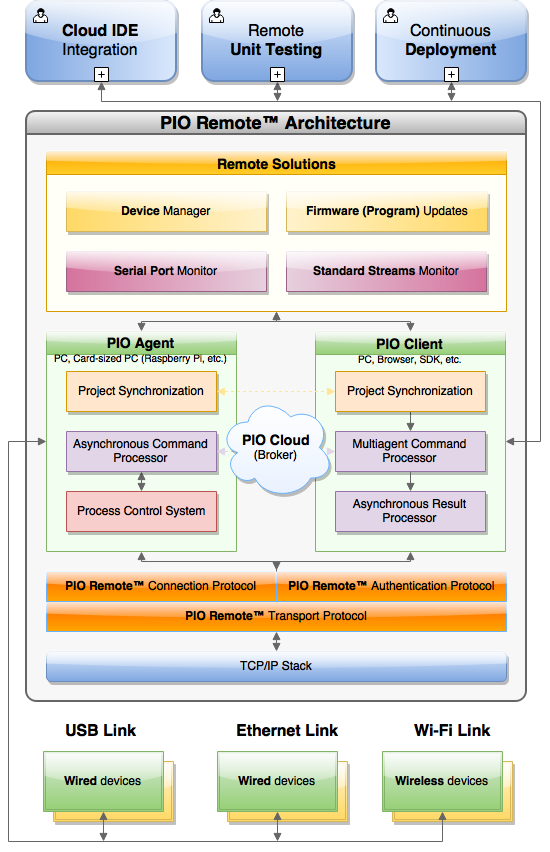Remote Development¶
Your devices are always with you!
PIO Remote Development Solution allows you to work remotely with devices from Anywhere In The World. No matter where are you now! Run a small and cross-platform PIO Remote Agent on a remote machine and you are able to list active devices (wireless + wired), to upload firmware (program), to process remote unit tests, or to start remote debugging session via Remote Serial Port Monitor.
Using PIO Remote Development Solution you can share your devices with colleagues across your organization or friends. In combination with Cloud IDEs, you can create awesome things at any time when inspiration comes to you.
You should have PIO Account to use PIO Remote Development Solution. A registration is FREE.
Features¶
Share devices with your team members
Continuous Deployment
Continuous Delivery
Remote Unit Testing
Use Cases¶
- Cloud IDE
Program your devices from anywhere in the world using the most popular Cloud IDEs. You do not need to install any extra software, no need to have static IP or open network ports. Everything works out of the box.
- Devices behind card sized PC
Work with your favorite development environment and program devices connected to card-sized PC (Raspberry Pi, Cubie Board, etc.). You do not need to open SSH ports, install any extra Linux packages, toolchains.
- Remote Unit Testing
Instruct any of Continuous Integration services to run remote tests on a physical device. See the documentation for Remote Test Runner.
How does it work?
You commit new changes to your source code repository
Continuous Integration service deploys unit tests to a remote agent
Unit Testing engine runs tests on a physical device, process them, and send results
Continuous Integration service prints results in human readable format
If one test fails, current CI build will fail too.
- Board Farm
A similar concept as described in “Remote Unit Testing” above. Let’s imagine that you need to test some logic on the unlimited number of target devices. Very often it can be the same hardware prototype but with different factory revisions.
You connect these devices via USB hub to PC and instruct PIO Remote Development Solution to process your test on ALL targets connected to a specific agent. See documentation below.
- Remote Serial Monitor
Sometimes you don’t have physical access to a target device but you need to read data from some serial port. PIO Remote Development Solution allows you to connect to a remote agent and list connected devices with their serial ports. See pio remote device monitor command for details.
Technology¶

PIO Remote Development Solution is an own PIO technology for remote solutions without external dependencies to operating system or its software based on client-server architecture. The Server component (PIO Cloud) plays a role of coupling link between PIO Remote Agent and Client (PIO Remote CLI, Cloud IDEs, Continuous Integration, SDKs, etc.). When you start PIO Remote Agent, it connects over the Internet with PIO Cloud and listen for the actions/commands which you can send in Client role from anywhere in the world.
PIO Remote Development Solution is multi-agents and multi-clients system. A single agent can be shared with multiple clients, where different clients can use the same agent. This approach allows one to work with distributed hardware located in the different places, networks, etc.
This technology allows one to work with remote devices in generic form as you do that with local devices using PIO ecosystem. The only one difference is a prefix “remote” before each generic PIO command. For example, listing of local and remote devices will look like pio device list and pio remote device list.
Installation¶
PIO Remote Development Solution is built into PIO IDE. Please open PIO IDE Terminal
and run pio remote --help command for usage (see PIO Remote CLI).
If you do not have PIO IDE, or use Cloud IDEs or a card-sized PC (Raspberry Pi, BeagleBoard, etc.), please install PIO Core (CLI).
Quick Start¶
Start PIO Remote Development Solution Agent using pio remote agent start command on a remote machine where devices are connected physically or are accessible via network. PIO Remote Development Solution Agent works on Windows, macOS, Linux and Linux ARMv6+. It means that you can use desktop machine, laptop or credit card sized PC (Raspberry Pi, BeagleBoard, etc).
You can share own devices/hardware with friends, team or other developers using
pio remote agent start --shareoption.Using host machine (PIO Remote CLI, Cloud IDEs Terminal in a browser, SDKs, etc.), please authorize via pio account login command with the same credentials that you used on the previous step. Now, you can use PIO Remote CLI commands to work with remote machine and its devices.
You don’t need to have networking or other access to remote machine where PIO Remote Development Solution Agent is started.
If you use PIO Remote Development Solution in pair with Continuous Integration or want automatically authorize, please set
PLATFORMIO_AUTH_TOKENsystem environment variable instead of using pio account login command.
Note
In case with Cloud IDEs, your browser with Cloud IDE’s VM is a “host machine”. The machine where devices are connected physically (your real PC) is called “remote machine” in this case. You should run PIO Remote Development Solution Agent here (not in Cloud IDE’s Terminal).
Note
Please use local IP as “upload port” when device is not connected directly
to a remote machine where PIO Remote Development Solution Agent is started but supports natively
Over-the-Air (OTA) updates. For example, Espressif 8266 and
Over-the-Air (OTA) update. In this case, the final command for remote
OTA update will look as pio remote run -t upload --upload-port 192.168.0.255
or pio remote run -t upload --upload-port myesp8266.local.
